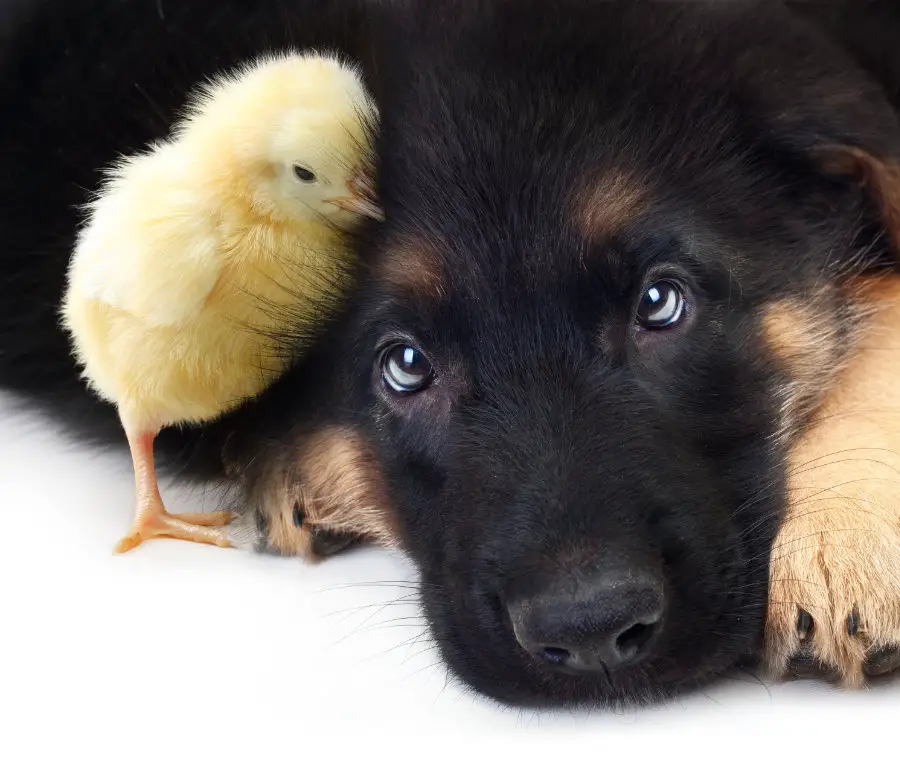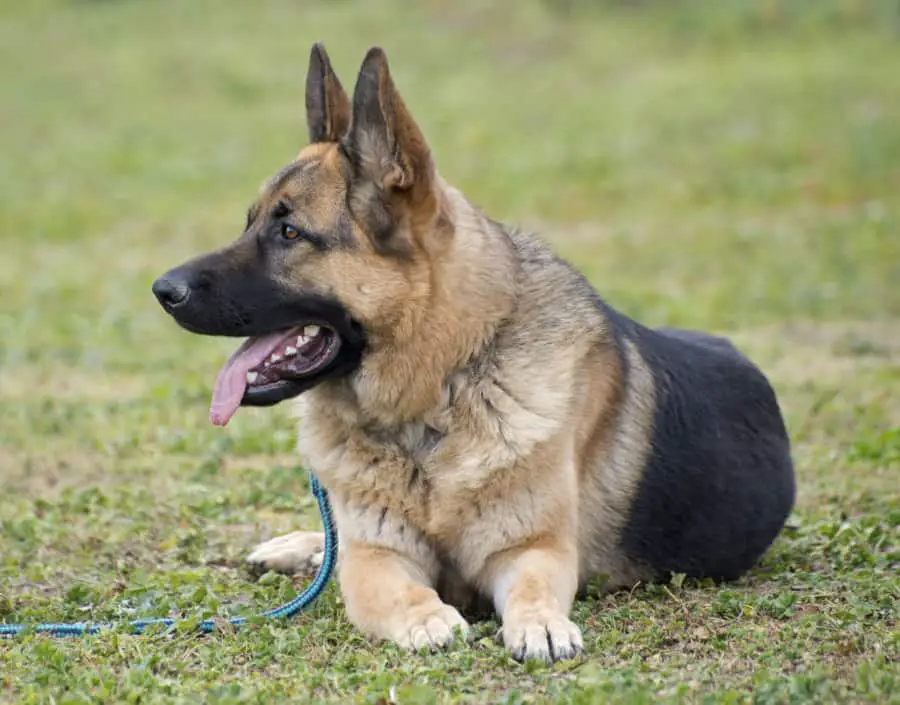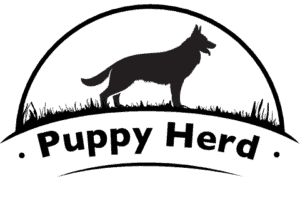For any animal with carnivorous tastes, a chicken can be hard to resist. Even the most well trained and socialized dogs can have a hard time stopping themselves from trying to eat a chicken if the chance presents itself. This is true even with dogs that were bred to herd other animals – like German Shepherds.
German Shepherds can be good with chickens if properly exposed, trained, and socialized. But, like most dogs, a German Shepherd will have the instinctual urge to hunt, kill, and eat chickens. A German Shepherd that has not been around chickens should not interact with them unsupervised.
German Shepherds are an immensely intelligent dog breed and can be trained to do nearly anything you can think of. While they do have a strong, instinctual predatory drive, they can be trained on what is not acceptable as a prey animal. They also possess a great deal of innate talent for herding and protecting livestock, hence the shepherd part of their name. In this article, we will take a closer look at German Shepherd and chicken interaction.
German Shepherds And Chickens
It is just a fact of life, everything likes chicken. There is a reason that we need to keep them in coops and behind fences. We even need to make sure they have protection above them as every predator and omnivore of land, sea, and air would love to have themselves a chicken dinner any day of the week. This is the same for man’s best friend.
Even the most gentle of dogs might start to salivate when they get their first glimpse of a chicken. They can’t help it, it is in their DNA, just as it was for their most ancient ancestors.
Luckily for us, German Shepherds can be trained out of their urge to eat every chicken they see, no matter how plump and delicious they may look. It is important that you introduce your dogs to chickens early on and continually as they grow in order for them to learn to live alongside their feathered friends.
Before you introduce your dog to your chickens, there are a few things that your dog should learn.

Before Dog Meets Chicken
You probably shouldn’t introduce your dog to the chickens when it is still a puppy. Puppies might not have the power to kill a chicken but that drive is still there. That, combined with their not so great grasp of basic training can result in some roughed up chickens and a puppy that has received a painful pecking.
To make matters more frustrating if a puppy learns early on that chickens are to be feared for their fearsome beaks, it may be more difficult to train out their hostility towards the birds.
Only after a dog is around a year in age, and has learned a few basic commands, should they be able to meet the chickens. Your dog should know how to:
- Sit: And to do so on command and without the bribe of a treat.
- Stay: This is important so that they don’t rush the chicken and startle them. Once the chickens are riled up it’s time to end training for the day.
- Leave it: Most importantly, the dog needs to have enough discipline to leave things alone when given the command. Once the chicken is in the dog’s mouth, things have gone poorly.
Having these fundamentals in place not only helps you get a better grasp on introduction training, but it will also help your dog to understand the concept of training and be better geared towards learning and accepting new ideas and behaviors.
Since chicken lives are on the line, you and your dog should be on the same page. Luckily, teaching an intelligent dog like a German Shepherd these basic fundamentals should not take too long.
How To Introduce Your Dog To Your Chickens
The best place to do the introduction is in a large open space so that there is plenty of room for the chickens to roam and enough room to be able to give them a wide berth while you are doing your training.
If you only have a coop, it might be difficult to get a handle on things if the situation goes awry. If a dog feels like they are both trapped and surrounded by delicious chickens, things could go downhill, fast. If you don’t have any other option, you might have to get creative, but a yard or field is best.
With your dog on a leash, you’re just going to take a walk past the chickens. Walk around the chickens, not too closely, and act as if this is just your normal, everyday walk. If your dog lunges or shows predatory posturing towards a chicken, you must stop and wait.
This is where praise and treats come in. When your dog is focused on the chickens, you need to take that focus and put it on you. You can do this by giving your dog a command as soon as they show interest in the chickens. The moment they break that focus and turn towards you, reward that action with praise and a high-value treat, like cheese, meat, or whatever it is that they really love.
Immediately give them a command to sit, stay, lay, etc… to further pull their focus to you and reward again. Then, you continue to walk. Repeating those steps until you feel you’ve made a touch of progress.
If you find it impossible to pull your dog’s focus to you, you can back off and put more distance between you and the chickens. If you find that you can’t get any closer without your dog losing their mind, just keep it at that distance and call it a day. Like any form of training, it can take a few days for small pieces of the training to click into place. Be patient with your dog and yourself and try again the next day.
Every day you should walk closer to the chickens. Closer and closer, more and more until your dog is bored with your walk-around-the-chicken walks. Once that urge to lunge at the chickens has lost its novelty, you can move onto the next step.

Visiting The Chickens Without A Leash
Once your dog is bored with chickens, it is time to go leashless. It is important to go about this training exercise with confidence and calmness. If your dog senses that you are too anxious and fearful, they will pick up on that. If they sense that you are nervous it can make them harder to control and less likely to respect your commands. It can make them more likely to act spontaneously, completely forgetting all prior training. So, walk tall and with confidence, like the alpha you are, as you go to visit the chickens.
Each dog reacts to different aspects of training differently. Some dogs may be completely fine after the first act of leash training while others might get a renewed craving for chicken flesh.
If you sense that your dog is reacting to the chickens, it is time to reenact the previous exercise. Get your dog’s attention, reward, command, reward again, then continue as normal. If you find that your dog is reacting too strongly to the chickens and you can’t seem to pull their focus, it is time to end the training session and try again tomorrow.
If this continues and you make no progress, it may be that you need to go back to square one and restart the leash training. When they do good in training, make sure to reward them heavily, and continue to spend time with them afterward. By showing your appreciation and love after the training, they will try to recreate that in their training the next day.
Eventually, the training of taking the focus away from the chickens combined with your dog’s growing boredom of the entire situation should result in them accepting that the chickens are friends and not food.
You should still show some hesitancy while they are around the chickens, and not leave them unsupervised until you are sure that they no longer react like a predator around the flock. Soon enough they should accept that they are a flock to be shepherded and not just plump, feathered snacks.
You might want to consider different methods on how to train your dog. Sometimes, a dog won’t take to one training method, but will easily understand another.
The Nature Of Dogs And Chickens
All dogs can be trained to know not to hurt chickens, but different breeds will have their struggles. Hunting dogs, varmint-exterminators and bully breeds can have a higher than average prey drive.
Even working dogs like the German Shepherd can have a hard time with chickens. In the wild, small game, like chickens, are a very valuable prize for any predator that is trying to survive on their own. So, we can’t blame them for the way that seeing a chicken makes them feel.
It is possible that one dog may learn the training fast and can be trusted to lay around with the chickens all day, accepting them as their own family. Another dog may seem fine until you are out of sight, then goes in for the kill. It may take some trial and error, and that can mean that there are some injured, or dead chickens at some point.
It is tragic, as we do grow fond of our chickens and we want what is best for our dogs at the same time. It is important to remember that just because a dog kills a chicken, that it isn’t a bad dog, and it isn’t the animal’s fault. It is the natural order of things. It is us, as humans, that have decided to make it confusing for the dogs that just want a delicious meal.
Sometimes, when a dog does kill a chicken, they can end up killing more than one. They might even kill every chicken they can get to. Again, this isn’t their fault and they are not doing it out of malicious intent. When a predator animal’s prey drive is engaged, all of their instinctual memory is telling them to kill. The more animals that they kill, the better they feed their pack and their offspring. It is part of their nature to go on a berserk killing spree. It is brutal, but it is nature’s way.
An important thing to remember is that just because a dog has killed a chicken or even an entire flock of chickens, they are still redeemable. They can be trained new habits and learn to live amongst chickens, even let alone, after having killed.

The Case For A Low Prey Drive
Prey drive is the innate drive that dogs possess to hunt and kill their prey in order to feed themselves. It was an essential part of their evolution, though, now it is commonly seen as a problem. Especially when chickens are involved.
If what you are looking for is a dog breed with a low prey drive that is going to be easier to train around chickens, here are some breeds that may be easier to make friends with your flock.
- Maltese: Not only are they most likely too small to kill a chicken, but they are known for being pretty lazy. Why kill things when there is a soft couch to lay on?
- French Bulldogs: Another breed that might just be too lazy for its own good. Plus most Frenchies tend to be small in addition to being averse to running.
- Golden Retrievers: Golden Retrievers just want to be everybody’s friends. They certainly could kill a chicken if they wanted, but it should be easier to train away, especially if they are raised with chickens.
- Papillon: A dog named after a butterfly should not be expected to be a murderer of fowl. Especially when they are smaller than a chicken.
- Vizsla: They were bred to hunt, but somewhere along the evolution of their breed they became very lazy and would rather snuggle than hunt.
- Cavalier King Charles Spaniel: Another dog too small to be a danger. You may need to be more worried about the chickens coming after them.
- Boxer: Like Goldens, Boxers just want everyone to get along. They would much rather play than hurt anyone, even if it is a delicious chicken. They might try to play with the chickens, though they’d quickly find that the chickens aren’t really into that.
- Great Pyrenees: Kind of surprising actually, coming from such a large dog. They may be imposing, large dogs, but they were bred to protect other animals, not eat them. Though, if they chose to, it might only take them one bite to eat a chicken.
- Bichon Frise: A Bichon would probably rather bark at a chicken than try to eat it. Most likely they would annoy your chickens to death before they would attack them.
- Japanese Chin: Chins are known for acting more like cats than dogs. That, and they are famous for their calm demeanor. They might be a great choice for a chicken friend.
- Old English Sheep Dog: Another big breed that was bred to help other animals, not hurt them. An old English sheepdog might decide it would rather fight wolves than fight a chicken.
- Havanese: Another little fluff ball that would rather cuddle than kill. They are sweet dogs and their size would make them easier to train around fowl.
- Irish Setter: A brilliant breed that listens well. They might have a glimmer of that prey drive, but they should easily train to be friends with all manner of animals, big or small.
- Coonhound: Coonhounds are a hunting breed, but they tend to be very sociable and love to make friends. They are also big people-pleasers, so, when you tell them no, they listen.
- Beagle: Beagles are playful and loud, but they aren’t born killers. They love to be part of big packs of animals, and they can be very sensitive and emotional.
- Pomeranian: Pomeranians act like the king of the castle, but when push comes to shove, they usually run away.
Maybe a German Shepherd isn’t the type of dog you are looking for. If you are wondering if the breed is the best for hanging around chickens, unsupervised.
That’s not to say that you can’t train a German Shepherd to behave around poultry, because they are capable of great feats of intelligence. But, if you want an easier go of it, and you can’t stomach the thought of a dead chicken, check out some other breeds first.
